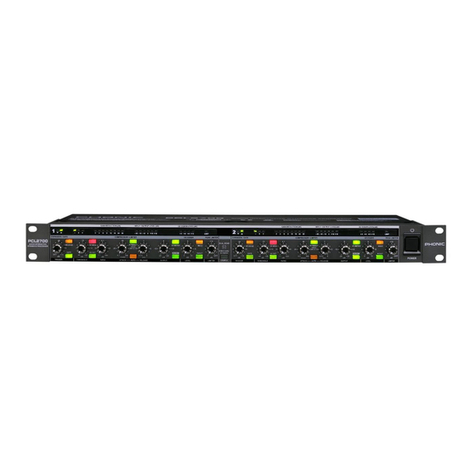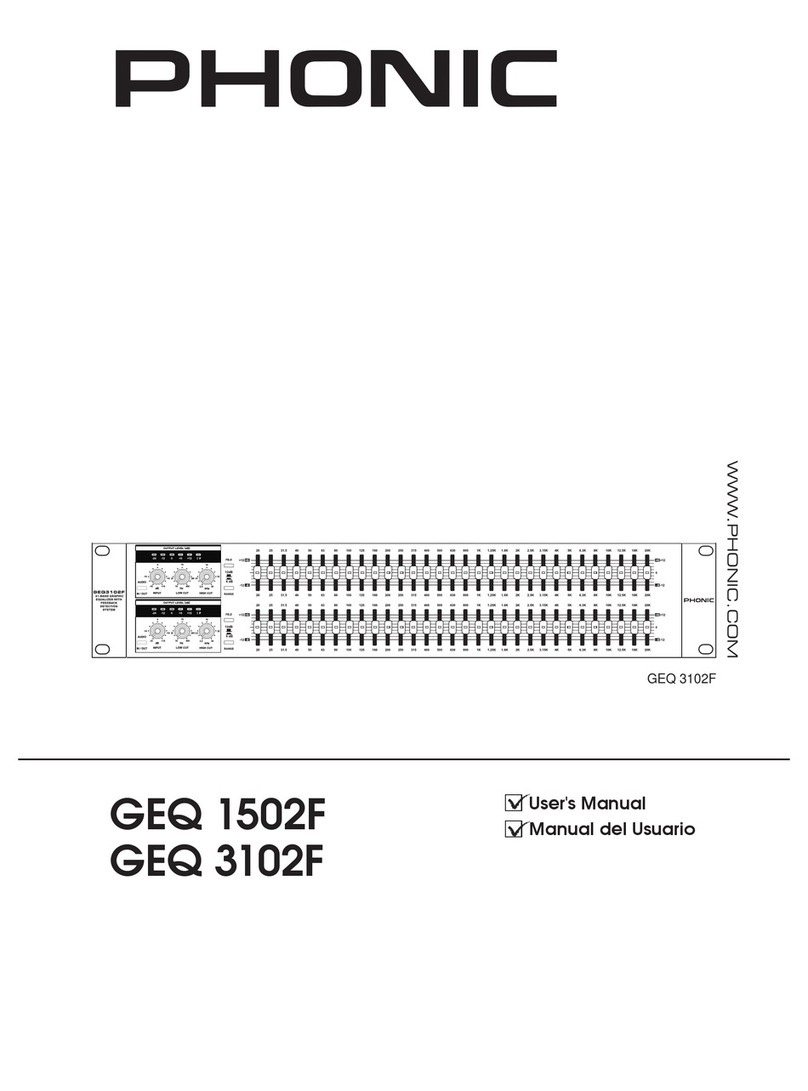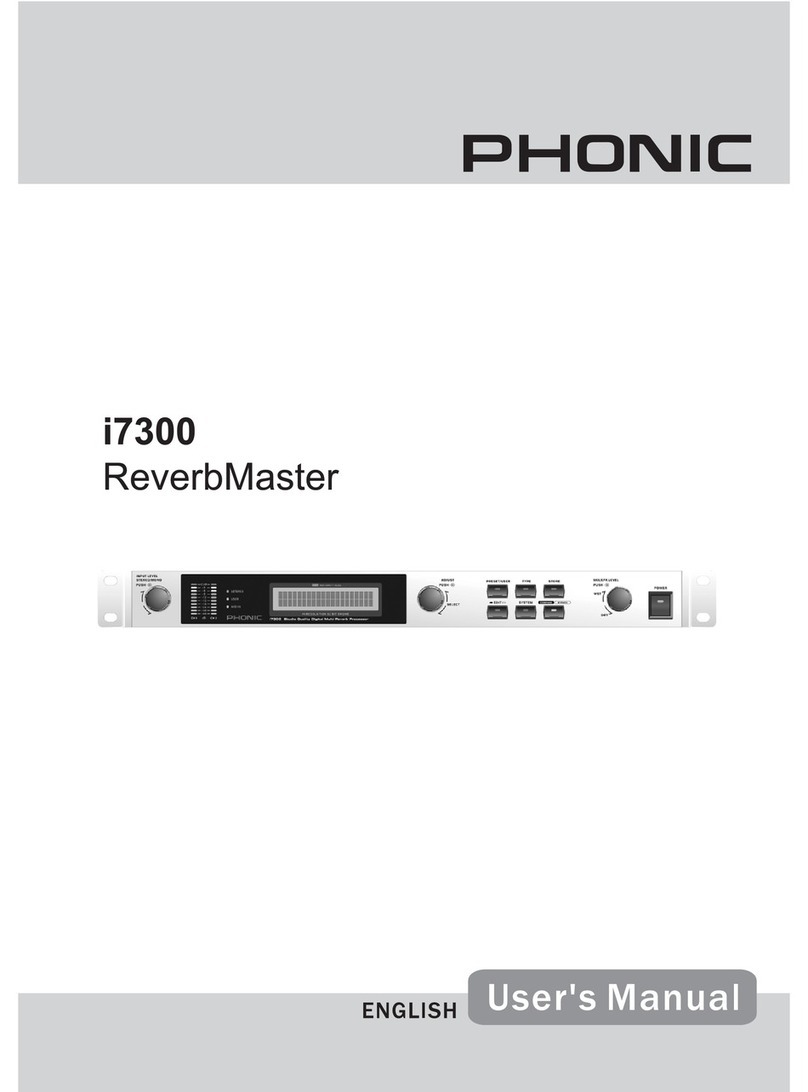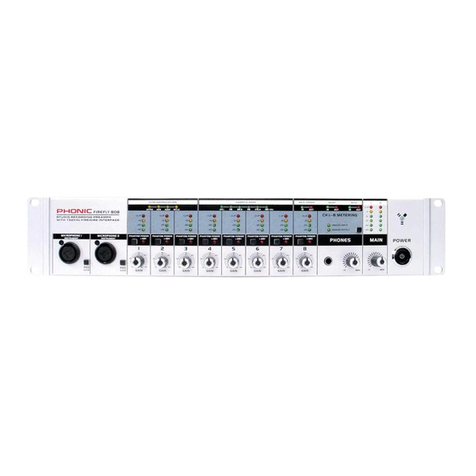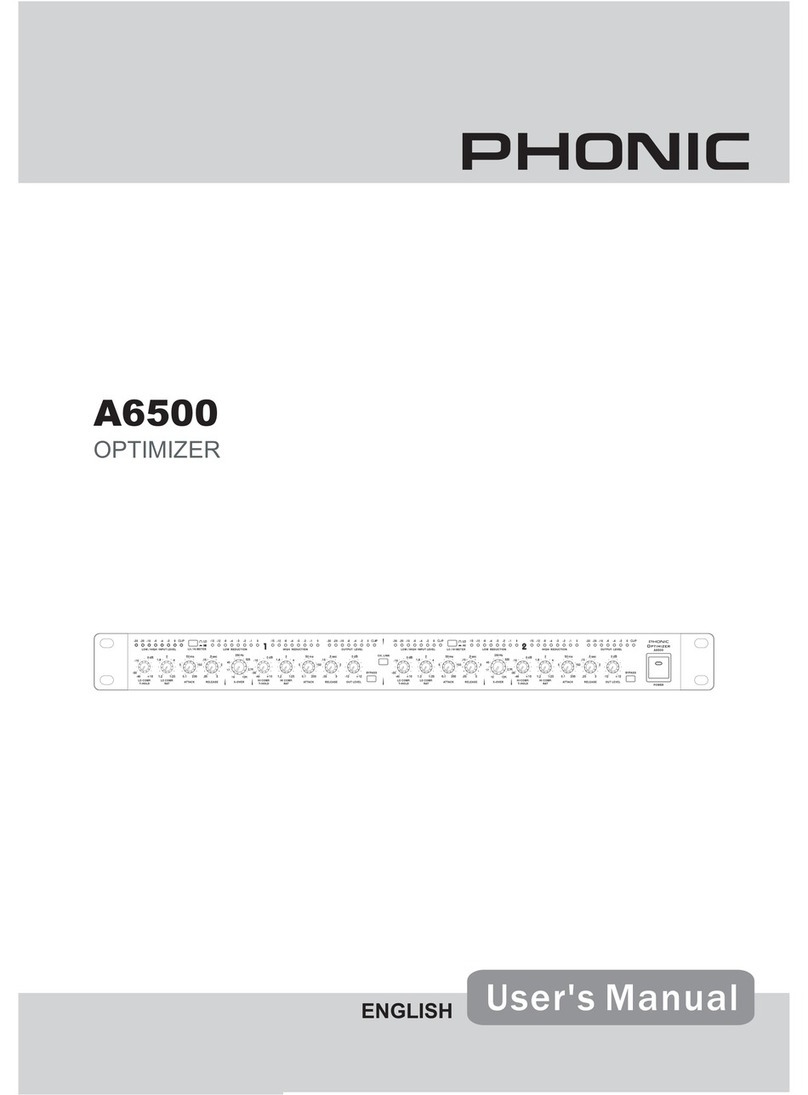Phonic Road Gear 160 User manual

V1.4 2004/10/1
Road Gear 160 / 260
Integrated Mobile Sound System

1. Read these instructions before operating this
apparatus.
2. Keep these instructions for future reference.
3. Heed all warnings to ensure safe operation.
4. Follow all instructions provided in this document.
5. Do not use this apparatus near water or in locations
where condensation may occur.
6. Clean only with dry cloth. Do not use aerosol or
liquid cleaners. Unplug this apparatus before
cleaning.
7. Do not block any of the ventilation openings. Install
in accordance with the manufacturer
’
s instructions.
8. Do not install near any heat sources such as
radiators, heat registers, stoves, or other apparatus
(including ampliers) that produce heat.
9. Do not defeat the safety purpose of the polarized
or grounding-type plug. A polarized plug has two
blades with one wider than the other. A grounding
type plug has two blades and a third grounding
prong. The wide blade or the third prong is provided
for your safety. If the provided plug does not t into
your outlet, consult an electrician for replacement of
the obsolete outlet.
10. Protect the power cord from being walked on
or pinched particularly at plug, convenience
receptacles, and the point where they exit from the
apparatus.
11. Only use attachments/accessories specied by the
manufacturer.
12. Use only with a cart, stand, tripod,
bracket, or table specied by the
manufacturer, or sold with the
apparatus. When a cart is used,
use caution when moving the cart/
apparatus combination to avoid
injury from tip-over.
13. Unplug this apparatus during lighting storms or
when unused for long periods of time.
14. Refer all servicing to qualied service personnel.
Servicing is required when the apparatus has been
damaged in any way, such as power-supply cord or
plug is damaged, liquid has been spilled or objects
have fallen into the apparatus, the apparatus has
been exposed to rain or moisture, does not operate
normally, or has been dropped.
IMPORTANT SAFETY INSTRUCTIONS
CAUTION: TO REDUCE THE RISK OF ELECTRIC SHOCK,
DO NOT REMOVE COVER (OR BACK)
NO USER SERVICEABLE PARTS INSIDE
REFER SERVICING TO QUALIFIED PERSONNEL
!
The lightning ash with arrowhead symbol, within an
equilateral triangle, is intended to alert the user to the
presence of uninsulated
“
dangerous voltage
”
within the
product
’
s enclosure that may be of sufcient
magnitude to constitute a risk of electric shock to persons.
The exclamation point within an equilateral triangle is
intended to alert the user to the presence of important
operating and maintenance (servicing) instructions in the
literature accompanying the appliance.
WARNING: To reduce the risk of re or electric shock, do
not expose this apparatus to rain or moisture.
CAUTION: Use of controls or adjustments or
performance of procedures other than those specied
may result in hazardous radiation exposure.
!

TABLE OF CONTENTS
page
Integrated Mobile Sound System
RoadGear 160/260
Introduction ...................................................................................................................4
Features..........................................................................................................................4
RoadGear Components ................................................................................................5
Disassembling The RoadGear......................................................................................6
Initial Setup ....................................................................................................................6
The RoadGear Mixer......................................................................................................7
Making a Connection ....................................................................................................................7
Digital Effects Panel......................................................................................................................9
Master Controls .............................................................................................................................9
The RoadGear Speakers.............................................................................................10
Microphones ................................................................................................................10
Optional Accessories..................................................................................................10
On The Road Application............................................................................................11
Specications ..............................................................................................................12
Some Important Information ......................................................................................13
The Combination Docking Lock ............................................................................................................13
Latch Position..............................................................................................................................13
Speaker Load ...............................................................................................................................14
Connecting the Portable Power Supply.....................................................................................14
Carrying The Speakers................................................................................................................14
External DC Power Supply Inlet .................................................................................................14

page 4 RoadGear User's Manual PHONIC CORPORATION
page 5
PHONIC CORPORATION RoadGear User's Manual
Introduction
We at Phonic would like to congratulate you on purchasing one of the RoadGear mobile audio systems, a
set of audio equipment superior in design and versatility. The Phonic RoadGear sets allow you to take all
the equipment you need to setup an advanced, all-in-one integrated sound system anywhere you go, with a
minimum of fuss. The fully self-contained unit includes two full-range speakers, a powered mixer, and dynamic
microphones, as well as all the necessary cables. RoadGear also gives you the option of using wireless
microphones and supplies enough storage space to pack them conveniently away.
Setting up the RoadGear set could not be easier. Just release the docking lock, and, after disassembling the
mobile kit, simply position the speakers, and plug them, the microphone, and any other instruments or devices
you wish, into the powered mixer. After plugging the powered mixer into an appropriate power supply, your
system is ready to use. Not only is it this simple to set up, however, but using the system is also simplistic.
Using the controls of the supplied powered mixer, adjust the levels of the inputs, as well as the high, low, and
middle frequencies of the inputs, and the digital effects processor. All these features make the RoadGear an
easy and convenient solution to a mobile sound system.
This user’s manual is specically designed to give you accurate information on the function and use of
the RoadGear 160 and 260. After thoroughly reading this manual, it is suggested you store it in an easily
accessible place for future reference.
RoadGear 160 & 260 Features
● Convenient and complete audio package with a stylish luggage-type molded PP casing, making for
increased sturdiness.
● Large Polyurethane wheels, for an extra smooth ride and durability.l 3-band system equalizer.l Two 30 foot
speaker cables.l Speaker output with send and return.l Storage compartments for microphones, cables and
other accessories.l Optional external battery and wireless microphone.
RoadGear 160 additional features
● 160 watts of output power (80 watts per chan-
nel).
● Speaker system with 1” compression tweeters
and 8” woofers for high pressure sound repro-
duction.
● Total 4-channel input powered mixer.
● 2-band EQ on each input channel.
● One dynamic microphone with cable.
● 3 XLR mic inputs with phantom power.l 1 stereo
input channel and 1 stereo aux return.
● High-Denition digital multi-effect processor with
4 programs.
RoadGear 260 additional features
● 260 watts of output power (130 watts per
channel).
● Speaker system with 1” compression tweeters
and 8” woofers for high pressure sound
reproduction.
● Total 6-channel input powered mixer.
● 2-band EQ on each input channel.
● Two dynamic microphones with cables.
● 4 XLR mic inputs with phantom power.l 2 stereo
input channel and 1 stereo aux return.
● High-Denition digital multi-effect processor with
16 programs.

page 4 RoadGear User's Manual PHONIC CORPORATION
page 5
PHONIC CORPORATION RoadGear User's Manual
RoadgearComponents
RoadGear 160
● Two Speakers with specially molded enclosures
● One powered mixer built into a specially molded storage case
● One Phonic UM 99 microphone with 20 foot (6 meter) cable, clip and pouch.
● Two 30 foot (9 meter) speaker cables
● Detatchable power cable
● One transparent dust cover
RoadGear 260
● Two Speakers with specially molded enclosures
● One powered mixer built into a specially molded storage case
● Two Phonic UM 99 microphones, each with a 20 foot (6 meter) cable, clip and pouch.
● Two 30 foot (9 meter) speaker cables
● Detatchable power cable
● One transparent dust cover
Caution
!
● Use the AC power cable supplied with the RoadGear sets only.
● When buying the RoadGear, the AC power cable will be specic to the safety and code requirements of the
Country of purchase.
● The ground (earth) pin of the AC power cable’s male connector should under no circumstances be
removed.
● When taking the RoadGear abroad, check the local voltage and ensure an appropriate power level is used,
as selected by the power selection switch on the back panel. (eg. If the local standard is between 100 and
120 Volts, the 115 volt power level should be selected. If the standard is between 220 and 240, then 230
volts should be selected).
● When the RoadGear is in use, the storage compartment door must be kept open for better ventilation.

page 6 RoadGear User's Manual PHONIC CORPORATION
page 7
PHONIC CORPORATION RoadGear User's Manual
Disassembling The RoadGear
To follow is the most convenient way to open
and close the RoadGear kits. Following these
instructions will ensure trouble-free setup of the
RoadGear.
1. You should rst unclip docking locks 1 and
2 (indicated below) on either side of the
RoadGear.
2. After unhooking these docking locks you can
then open the top lock
3 . This ensures the RoadGear pieces come apart
smoothly.3. Stand the powered mixer upright.
4. To re-assemble the RoadGear pieces, the same
order should be taken (side locks rst, followed
by the the top). This way the pieces will be held
securely and rmly together.
5. When using the RoadGear speakers, ensure
that the docking locks on the rear are locked
back into place, to ensure they don’t scratch the
surface on which they sit.
Initial Setup
Please ensure you take note of all setup
instructions listed in this manual. The RoadGear
160 and 260 are both used as normal PA
systems and therefore all care should be taken
in ensuring the correct setting up of equipment.
1. Disassemble the mobile RoadGear set and remove
the speakers from the top of the kit. Remove all
items you wish to use in your PA system from the
RoadGear’s storage area. Also, place the mixer
and speakers in a suitable place.
2. Connect the two speakers to the Powered Mixer,
via the supplied speaker cable. An optional
speaker stand may be used to increase the
height of the speakers. NB. No devices other
than speakers should be connected to the
speaker outputs. Doing so will likely cause
damage to the device. Also, guitar cables should
not be used to connect ampli ers to speakers.
3. Plug all necessary instruments and equipment
into the device’s various inputs as required.
This may include line-signal devices, as well as
microphones and/or guitars, keyboards, etc.
4. Plug any necessary equipment into the device’s
various outputs. This could include monitors,
signal processors, and/or recording devices.
5. Ensure all input and out levels are set to the left-
most position.
6. Plug the supplied AC cable into the AC inlet on
the back of the RoadGear mixer.
NB. Ensure the power cable has no scratches or cuts that may
reveal the wire beneath before plugging into the provided
powered mixer as constant setting up and disassembling of
equipment may cause insulation to wear.
7. Plug the supplied AC cable into a power outlet of
a suitable voltage.
8. Turn the mixer power switch to the on position
and set all input and output at appropriate levels
to suit your needs.
9. When the RoadGear is in use, the storage
compartment door must be kept open for better
ventilation.
1

page 6 RoadGear User's Manual PHONIC CORPORATION
page 7
PHONIC CORPORATION RoadGear User's Manual
The RoadGear Mixer
The powered mixer provided with the RoadGear
package is equipped with 4 microphone and line
input jacks (3 on the RoadGear 160), as well as 2
stereo inputs (1 on the RoadGear 160), and a built in
effect processor boasting a 24-bit DSP. All this, plus
a basic 3-band system equalizer, ensures your audio
always sounds great, on the road.
Making a Connection
1. Microphone Input Jacks
These XLR jacks are for the input of low level
signal devices, most commonly, microphones.
For best performance, we suggest using the
microphones supplied with the RoadGear set,
however they can be used in conjunction with
any professional condenser, dynamic or ribbon
microphones with standard 3-pin XLR male
connectors.
2. Line Input Jack
These 1/4” TS phone jacks accept a wide range
of input line level devices, such as guitars and
keyboards. It can accept unbalanced sources,
however any microphones plugged into the
microphone input will not work when a line
device is attached to this system.
3. Stereo 1 and 2 Inputs
These inputs include 2 sets of jacks, one set
being standard stereo RCA jacks, the other
being stereo 1/4” TS phone jacks, and can be
used for the addition of certain playback devices,
such as CD players, cassettes, or DAT to the
mixer. The RCA and TS jacks can both be used
simultaneously; however, in some cases this is
unadvisable as the blending of audio may have
undesirable results. The audio fed into these
inputs is fed to the corresponding stereo input
mixing bus.
4. Tape Out
These outputs will accommodate RCA cables to
be fed to a variety of recording devices, such as
tape and digital recorders.
5. Effects (EFX) Out
These 1/4” TS outputs are the nal output from
the effects send mixing bus. This feed may be
used to connect to an amplier and speakers, or
to external digital effect processors. When using
external processors, the feed can be returned to
the Stereo AUX Return ports.
6. Foot Switch
This port allows the inclusion of a foot switch for
remote alteration of digital effect properties (on
or off).
7. Stereo AUX Return (St AUX Rtn)
These TS inputs connect the mixer with parallel
external devices, such as sub mixers or external
effect processors, receiving the processed
signal from another source and feeding it to the
main mixing bus.
8. Send and Return
These connectors allow external signal
processing devices to be connected to the built-in
power amplier. Devices that may be connected
to these jacks may include equalizers, external
effect processors, feedback silencers, and so
forth. It is important to keep unity in the send and
return signal levels of external devices, as to
ensure overloading of inputs does not occur.

page 8 RoadGear User's Manual PHONIC CORPORATION
page 9
PHONIC CORPORATION RoadGear User's Manual
9. Speaker Outputs
These jacks are used to connect to speakers, fed from the internal power amplier. Both sets of outputs are
1/4” TS jacks, which boast an amazing 130 Watts of output (80 Watts for the RoadGear 160) per channel.
To use these, simply insert the RoadGear speaker cable’s 1/4” TS plug into them.
NB. Due to the fact that the signal has been processed by the power amp, these ports should be used in conjunction with speakers only
to avoid damaging any other equipment.
Controls and Settings
10. Peak Indicator
This indicator illuminates during high peaks of audio. If this LED illuminates
too often the input level of the corresponding channel should be reduced
to ensure the audio is not clipped when the level gets too high, which
would cause problems in the quality of audio.
11. High Frequency Control
This control alters the degree of high frequencies – or treble – in the audio
of the corresponding channel. Turn clockwise to increase the amount
of treble in the sound, and counterclockwise to decrease the amount.
Position the knob for a at response when not in use.
12. Low Frequency Control
This control alters the degree of low frequencies – or bass – in the audio of
the corresponding channel. Turn clockwise to increase the amount of bass
in the sound, and turn counterclockwise to decrease the amount. Position
the knob at “0” if not in use.
13. EFX Control
This control adjusts the signal level of the corresponding channel to
be sent to the EFX (or monitor) mixing bus, for internal digital effect
processing (as well as the monitor outputs).
14. PAN/BAL Control
This alternates the degree or level of audio that the left and right side of
the main mix should receive. On mono channels, this control will adjust
the level of the monaural signal that the left and right should receive,
where as on a stereo channel, adjusting the BAL control will increase and
attenuate the left or right audio signals accordingly.
15. Level Control
This control alters the audio level of the audio feed to the main mix. This
control should be set to the extreme left when the channel is not in use.

page 8 RoadGear User's Manual PHONIC CORPORATION
page 9
PHONIC CORPORATION RoadGear User's Manual
Multi-Effect Processor
16. On/Off Switch and Indicator
This switch is used to turn the corresponding effect panel on or
off. When the effect processor is turned on the corresponding LED
illuminates.
17. Effect Master Level
This control adjusts the level of the audio to be sent from the
corresponding digital effect procesor to the main mixing bus.
18. Program Control
This control is used to scroll through the various effects shown on the
Multi-Effect Display. Turning the control will automatically change the
program and apply it to the audio.
19. Effect Display
This panel contains numerous LED indicators that illuminate when
their corresponding digital effect is selected using the Program
control.
Master Controls
20. 3-Band Equalizer
The RoadGear’s built in 3-band provides perfect control over the high,
low and middle frequencies of your audio. Changing the level of high
frequencies included in your audio will enhance the treble sounds, such as
guitars, as well as enhancing the crispness of vocals. Changing the level of
low frequencies in your audio will enhance bass sounds, including drums
and bass guitars, and add to the overall warmth of the sound. Changing
the middle frequencies can be difcult, but cutting them to the right degree
can help to calm overly-harsh vocal and instrumental sounds.
21. Master Level Controls
This control is used to adjust the nal volume level of the MAIN LEFT/RIGHT or MAIN/MONITOR audio
to be sent to the power amplier and respective outputs, according to the mode selector settings.
22. Limiter Indicators
There are 2 limiters built-in to the stereo power amplier featured in the RoadGear 160 and 260. The
limiters are activated, and the indicator will illuminate, when the signal level becomes too high to warn
the user of the possibility of overloading. If this happens too often, ensure you to turn down the Master
Level Control down to a reasonable level. When using a 4 ohm load (ie. when both of the RoadGear
speakers are used on the same amp channel), please ensure the Limiter LEDs do not illuminate, as to
avoid overload.
23. Mode Selector
This is used to alternate the use of the power amplier outputs, depending on your setting. If stage
monitors are used in your set of speakers, then the switch should be set on the main/mon setting, which
will allow you to plug your left and right main speakers into the main power amplier outputs, as well as
a set of stage monitors for performers to listen to their audio. When set on left/right, both sets of power
amplier outputs can be used to output the left and right audio signals to up to four speakers.

page 10 RoadGear User's Manual PHONIC CORPORATION
page 11
PHONIC CORPORATION RoadGear User's Manual
24. Phantom Switch
This switch supplies +48V of phantom power to all microphone inputs, used for
powering condenser microphones.
NB. Do not use Phantom Power when any unbalanced microphones are in use.
25. Power Switch
This button is used to turn the device on and off. When Power is activated, the corresponding
indicator will illuminate.
NB. Turn the Master Level Control to a minimal level before turning the RoadGear on.
Rear Panel
26. Power Inlet
This port is used to plug the female end of the included
AC power cable. The other end should be connected to an
appropriate power source.
27. Voltage Selector
This switch is used to adapt the RoadGear to different Countries’ voltage levels. You are able to
select between 115 volts (which you can use in countries with standard voltages between 100
and 120) and 230 (which you can use in Countries with standard voltages between 220 and 240
volts)
The RoadGear Speakers
The specially molded speakers that are included in both sets provide 8 inch
woofers, as well as compression tweeters for high quality sound reproduction.
Included with the speakers are two 30 foot speaker cables.
Microphones
Included with the RoadGear sets will be a dynamic microphone (two with the
RoadGear 260), more specically the Phonic UM 99 microphone. The Phonic
UM 99 will no doubt supply you with a fantastically rened sound for use in
public addresses or even for vocals in live performances. Also included with each
microphone is a 20 foot (6 meter) microphone cable, clip and carry pouch.
Optional Accessories
In addition to all this, the RoadGear sets provide you with the option of using various added features.
Wireless microphones, with 2 module inputs conveniently placed in the compartment of the mixer, are a
fantastic way to ensure the microphone cord is never in the way. Speaker stands (along with additional
dual speaker mounts) and wall mounting kits, compatible with the RoadGear speakers, enable you
to position your speakers in a way that best suits your setting, and for a greater dispersion of audio.
The optional DC-DC converters and battery packs provide power to the RoadGear sets when no other
power source is around, and the travel bags allow protection and ease when traveling across Country
or overseas. These just add to the ease and convenience that RoadGear provides.

page 10 RoadGear User's Manual PHONIC CORPORATION
page 11
PHONIC CORPORATION RoadGear User's Manual
On The Road Application
The Phonic RoadGear sets are use the same was as an ordinary PA system would be, but with the
convenience of having all the components in one handy package, and as such, has the potential
to be set up in a variety different ways. Below is just one of the many possible examples we could
have given you in setting up the gear, hopefully giving you a good idea of the amazing possibilities
that RoadGear provides.

page 12 RoadGear User's Manual PHONIC CORPORATION
page 13
PHONIC CORPORATION RoadGear User's Manual
Specications
RoadGear 160 RoadGear 260
Drivers Compression tweeter & 8” woofer Compression tweeter & 8” woofer
Speaker Stand Adapter 35mm 35mm
Output Power 2 x 80W @ 8 ohms 2 x 130W @ 8 ohms
Channels 3 mono & 1 stereo CH, Peak
indicator, 2-band EQ, Efx send,
pan, level
4 mono & 2 stereo CH, Peak
indicator, 2-band EQ, Efx send,
pan, level
Mono Channel
Connectors
XLR & 1/4” TRS XLR & 1/4” TRS
Stereo Channel
Connectors
2 x 1/4” TS & 2 x RCA 2 x 1/4” TS & 2 x RCA
Multi-effect Processor 4 programs 16 programs
Foot Switch Effect On / Mute Effect On / Mute
System EQ 3-band 3-band
Amp Mode L & R or MAIN & MONITOR,
with limiter indicators
L & R or MAIN & MONITOR,
with limiter indicators
Speaker Out 2 x 1/4” TS per channel with insert
Send and Return
2 x 1/4” TS per channel with insert
Send and Return
Tape Out One Stereo RCA One Stereo RCA
EFX Out & ST Return Yes, 1/4” TS Yes, 1/4” TS
Phantom Power Yes Yes
Wireless Mic Module
Socket
2 (wireless microphones and receiver
modules are optional)
2 (wireless microphones and receiver
modules are optional)
Included Accessories 1 x Phonic UM99 microphone with
clip, 20’ cable, and carry pouch
2 x Phonic UM99 microphone with
clip, 20’ cable, and carry pouch
2 x 30’ speaker cables 2 x 30’ speaker cables
1 x detachable power cable 1 x detachable power cable
1 x PVC dust cover 1 x PVC dust cover
Power Requirement Switchable between 115VAC / 60Hz
and 230VAC / 50Hz, or optional
battery power
Switchable between 115VAC / 60Hz
and 230VAC / 50Hz, or optional
battery power
Dimensions (H x W x D) 818 x 635 x 352 mm
(32.2” x 25” x 13.9”)
818 x 635 x 352 mm
(32.2” x 25” x 13.9”)
Net Weight 28 Kg (61.7 lbs) 31.4 Kg (69.2 lbs)

page 12 RoadGear User's Manual PHONIC CORPORATION
page 13
PHONIC CORPORATION RoadGear User's Manual
Some Important Information
The Combination Docking Lock
The docking locks of the RoadGear are combination locks, which require the user to enter a pre-set
combination to open them. Please observe the following instructions to opening the lock.
1) The default code of the lock is 000. Please enter this code the rst time you use the RoadGear.
2) To change the lock’s code, rst open the latch and nd a small lever on the underneath of the lock.
Pull it towards the centre of the lock and up until it sticks into place.
3) Change the code dials to your desired secret code. Ensure you either remember the code by heart
or write it down somewhere, so as to not have to attempt to break the RoadGear apart in a way that
would not be favorable to your equipment.
4) After entering your desired code, replace the small lever underneath the lock into its original posi-
tion. And Voila! Your new, secret code is set.
Latch Position
Please ensure, after unpacking the RoadGear set, that the docking locks on the speakers are locked
back into place, to ensure the locks do not scratch the surface on which the speaker is standing.
Underneath The RoadGear Combination Lock

page 14 RoadGear User's Manual PHONIC CORPORATION
Speaker Load
The RoadGear Powered Mixer has a 4Ω load when both of the RoadGear speakers are used. In this
event, please ensure the Limiter LEDs, located by the Phantom Power switches, do not illuminate,
even for short ashes, as to avoid over load.
Connecting the Portable Power Supply
When connecting to the DC-DC power input ports, ensure the rightmost socket is used for the posi-
tive connection and the leftmost is used for the negative. The two middle sockets are for grounds.
Furthermore, a 48V supply should be used.
Warning: The power supply should not exceed 51VDC as to ensure the safe operation of the de-
vice.
Carrying The Speakers
Just a friendly warning: do not attempt to lift the RoadGear speakers with the coded latch below
the speaker handles. This could cause irreversible damage to the lock mechanism as they are not
designed to take the weight of the entire speaker.
External DC Power Supply Inlet
When using the optional rechargeable battery pack (model number BP-RG) and 12V DC-DC con-
verter (model number CV-RG) to connect to the DC-DC ports, located at the rear of the RoadGear,
ensure the rightmost socket is used for the positive 48VDC connection and the leftmost is used for
the negative 48VDC connection (the two middle sockets are for grounds).
Warning: The power supply should not exceed 51V as to ensure the safe operation of the device.
BACK VIEW
DC-DC CONNECTOR DRAW
+- GND GND
- 48 + 48

page 14 RoadGear User's Manual PHONIC CORPORATION

Other manuals for Road Gear 160
1
This manual suits for next models
1
Table of contents
Other Phonic Music Equipment manuals
